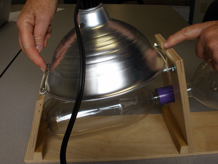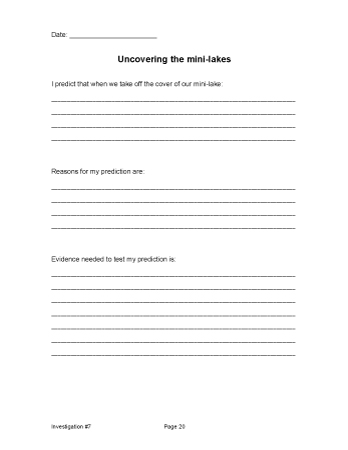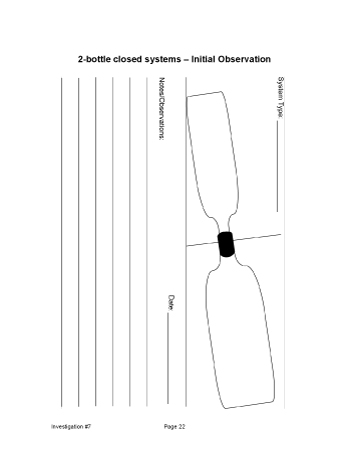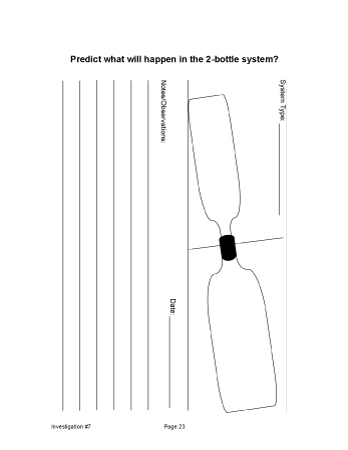What happened to the water?
Plan Investigation 7

Today students are introduced to three closed systems, called 2-bottle systems. These systems will allow them to investigate what happens to water once it evaporates. Does evaporation destroy water, or can students find evidence that it still exists, as they did to see if dissolved salt still exists?
One system holds fresh water and a sand-gravel-rock mix, one holds salt water, and one holds blue-tinted fresh water. Read more information about the 2-bottle system below.
By the end of this investigation students will understand how a closed system can provide evidence to help us explain a process we can't observe directly.
Learning Goals
- Understand the difference between an open system and a closed system
| Sequence of experiences | ||
|---|---|---|
| 1. Ask the question | All Class | 5 Mins |
| 2. Uncover the mini-lakes | Pairs | 15 Mins |
| 3. Introduce the 2-bottle systems | All Class | 15 Mins |
| 4. Observe and predict | Individual | 10 Mins |
About the 2-bottle system
The 2-bottle system is made of a 1-liter plastic bottle coupled to a 2-liter plastic bottle and held in position by a small stand. The system helps students deepen their understanding of the phase changes that are part of the water cycle, specifically the relationship between liquid water, evaporation, water vapor, and condensation. Three 2-bottle systems are used in this investigation.
Each of the lower, smaller bottles starts with 30 grams of water plus one other material (a sand-gravel mix, kosher salt, or blue food coloring). The inside of each lower bottle represents Earth's surface with an atmosphere and a body of water, and is warmed by a lamp. Each upper bottle initially contains only air. The upper bottle represents a "different place" to which water can travel in its vapor form, condense, and collect. It prevents evaporated water from just disappearing into the classroom air. Within approximately one week (if the lamps are left on continuously) all of the water in the warmer lower bottle will evaporate, and will condense and collect in the cooler upper bottle.

Why use a lamp, when evaporation can take place even at cooler temperatures? The 2-bottle system is a very tiny closed system in comparison with the system it attempts to model, which is the closed system of Earth and its atmosphere. The limited amount of air inside the bottles becomes extremely humid once evaporation starts. Such high humidity would slow and eventually stop net evaporation long before the water has completely evaporated from the lower bottle. The purpose of the lamp is to force evaporation to continue in spite of the high humidity in the closed 2-bottle system. Having all of the water in the lower bottles move to the upper bottles, leaving the sand-gravel mix, the salt, and the blue food coloring in the lower bottles, highlights the role that evaporation plays in the real world.
The bases that support the bottles also hold the lamps in the correct position. Set up as shown, and using a 100 watt bulb as specified, the lamps can safely remain on 24 hours a day. Turning the lamps off each night will dramatically extend the amount of time required to transport all of the water from the lower bottle to the upper bottle. We recommend turning the lamps off for school vacation periods.
Materials and Preparation
Preparation:

- Assemble three empty 2-bottle systems by connecting a 1-liter bottle and a 2-liter bottle using the special connector. Place each 2-bottle system in a base. Label one base lake materials, one base salt water, and one base blue water.
- Establish locations in the classroom where you can leave the three 2-bottle systems under their lamps. As necessary, set up the extension cords for plugging in the lamps. If necessary, the bottle systems can be moved to a more accessible location when students observe them closely and make drawings, but it's better if students can observe them without the systems being moved.
For the class:
- 3 12oz cups holding 30g of water
- 1 12oz cup holding 30g of a sand-gravel mix
- 1 12oz cup holding 5g of kosher salt
- blue food coloring
- 1 funnel; conical paper cup with 1/2" snipped off the end
For each group:
- 2 mini-lakes (from Investigation 1)
Concept Cartoon

The Evaporation Concept Cartoon is typically used as a formative assessment at the end of this investigation.









